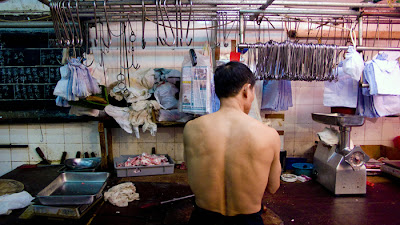
The F Blog received the following article from Cecilia Strandroth, PhD, Uppsala University. It´s an interesting contribution to our ongoing discussion about documentary photography, "reality or fiction" and the importance of photography as an independent form of art. Thanks Cecilia! /Ulf

My dissertation In Search of the Pure Photograph investigates some of the lesser known Farm Security Administration photographs made in the United States of the 1930s. The FSA photographs are today regarded as documentary icons, as masterpieces of 20th century American art, and as a national treasure. But this status also implies limitations. A national treasure could only contain things to be proud of.
There are thus also FSA photographs which never have become part of the national monument: photographs which could be described as “propaganda”. The FSA agency which employed the photographers was a part of Franklin D. Roosevelt’s New Deal. The photographers’ job was to make images used to market the government’s politics. They produced photographs of the government’s programs meant to aid the poor rural population. Some examples made by Marion Post Wolcott in Alabama portray the interaction between the local FSA personnel and their clients. Here, one could see fieldworkers for instance conducting evening classes and meetings, delivering medicines and clean linen and inspecting the farms’ animals. These activities are adhering to a fixed pattern of gender and ethnicity. Female fieldworkers discuss sewing and cooking with female clients, male fieldworkers discuss economy and agricultural matters with male clients. Caucasian fieldworkers meet with Caucasian clients, African American fieldworkers with African American clients. Exceptions are qualified personnel with an education. Caucasian doctors and nurses treat the diseases of the African American population. Power relations appear to be inscribed in the very bodies of the subjects of these images. Behaviours, postures and identities are performed according to fixed New Deal roles of class, gender and ethnicity. The photographs make visible how power was exercised, capture the ideology behind the New Deal’s programs.

Such images therefore deserve to be rescued from their present historical oblivion. They could be as important as sources of historical research as the generally famous FSA photographs. Such a usage has been hindered by the traditional interpretation of how the documentary value of the photographic image functions. It looks upon the documentary photographer as an eyewitness who stands beside the flow of life and captures aesthetically pleasing slices for eternity. This eyewitness or observer has to be passive, the document is regarded as compromised if influenced by intruding intentions, staging and rhetorical arrangements. This naturally makes the documentary value of FSA’s “propagandistic” photographs dubious.

But to photograph is not to passively observe and record, but an activity which in itself creates meaning. Looked upon in this way, a photograph is always inherently rhetorical, never an authentic observation. The FSA’s “propagandistic” photographs rather make explicit the construction present in all images. They function as sources exactly through being rhetorical, staged and arranged; they are not windows to the world but windows to an ideology.
©Cecilia Strandroth, PhD, Department of Art History, Uppsala University
In Search of the Pure Photograph. A Historiographic Study of the Farm Security Administration, Walker Evans, and the Survey Histories of Photography is available from Fronton förlag,
Photos by: Marion Post Wolcott, Coffee County, Alabama, 1939.
For more photos see FSA/OWI Collection, Prints & Photographs Division, Library of Congress, Washington D.C.
 Nadia Baram sent me an excellent collection of pictures for her guest appearance on the F Blog. In these pictures I am struck by the way this young woman portrays men of all ages. The photos are from China and Mexico and...yes, this is such refreshing work! Can´t wait for part two./Ulf
Nadia Baram sent me an excellent collection of pictures for her guest appearance on the F Blog. In these pictures I am struck by the way this young woman portrays men of all ages. The photos are from China and Mexico and...yes, this is such refreshing work! Can´t wait for part two./Ulf

 The Trouble with Being Two
The Trouble with Being Two

 Nadia Baram lives and works in Mexico City. She began studying photography when she was 9 years old at The Center for Contemporary Art in Mexico City. She later got a Bachelor of Fine Arts from Tisch School of the Arts at New York University on Photography and Imaging.
Nadia Baram lives and works in Mexico City. She began studying photography when she was 9 years old at The Center for Contemporary Art in Mexico City. She later got a Bachelor of Fine Arts from Tisch School of the Arts at New York University on Photography and Imaging.










